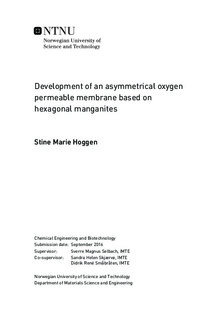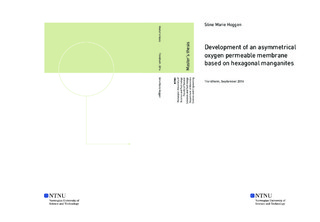| dc.description.abstract | Pure oxygen is a commodity chemical needed in many industries. Separation of oxygen from air is usually performed by the expensive and highly energy-demanding process of cryogenic distillation. A promising and more environmentally friendly alternative is the use of dense oxygen permeable membranes.
The state-of-the-art perovskite membranes require high operating temperatures (600--1000 C), which lead to membrane degradation and a short lifetime. There is a need for a new type of membrane material that will transport a sufficient amount of oxygen at lower temperatures. Hexagonal manganites have a crystal structure that allows for the incorporation of highly mobile interstitial oxygen ions, as opposed to the more dense perovskites, which need formation of oxygen vacancies to conduct oxygen. The incorporation of oxygen ions requires less energy than the formation of vacancies, and oxygen conduction can occur at lower temperatures (200-300 C). This makes hexagonal manganites very good candidates for oxygen permeable membranes. Hexagonal manganites often have highly anisotropic thermal expansion, which can cause microcracking in the membrane and reduced mechanical stability. Doping of hexagonal YMnO3 with titanium has shown to reduce this anisotropy and decrease the amount of microcracking in the material.
The aim of this study has been to find a fabrication route for an asymmetrical ceramic membrane based on titanium doped hexagonal YMnO3.
The solid state synthesis was used to create the porous support of the membrane, and the citric acid method was used to fabricate the nanoparticles for the functioning thin film. The nanoparticles were dispersed in a suspension and deposited onto the substrate using various deposition methods. The deposition techniques were spray coating, dip coating and drop casting, with drop casting giving the best results. The effect of the sintering temperature on the density of the film was also tested, showing that sintering at 1400 C or above was necessary to achieve a dense film. Yttrium vacancies were introduced in the material to test the effect on its sintering properties, and it was found that yttrium deficiency increases densification. A dense thin film was achieved by drop casting very fine particles of YMn0.85Ti0.15O3 onto a support, and sintering at 1400 C for one hour. Finally, a strategy in further development of the deposition technique is proposed in order to optimize the fabrication route. | |

